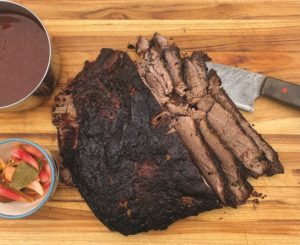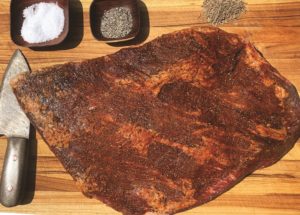I’ve been trying to move our household in the direction of a plant-based diet, turning out dals and stir-frys and vegetable-stuffed tacos with gusto. I even made a seitan-based chili that was surprisingly delicious. There are so many reasons to do this — personal health, animal health, planet health. And it’s for all these reasons that I’m sitting on the lawn at Edgewood Farm, listening to writers John “Doc” Willoughby and Mark Bittman discuss Bittman’s new book, Animal, Vegetable, Junk.
Bittman is a strong advocate for plant-based eating, and tonight he’s musing on the dismal future of, well, everything: industrial agriculture, society, the planet. That he remains so resolutely cheerful as he ticks off the things almost certain to go wrong with our world is impressive. This is important stuff, well researched and insightful. But I’m not feeling apocalyptic at the moment. I blame the gorgeous crepuscular colors in the sky above Truro.
As Willoughby makes a point, I remember the book he wrote with Chris Schlesinger, How to Cook Meat, and, from there, my mind wanders to barbecue. Suddenly, I don’t want a bean stew. I want the lip-smacking result of that low, slow, smoky alchemical method that transforms meat into a magical summertime meal. If there is to be salad, we’ll have potato to go with. I’m sorry, Mark, but this summer cannot end without barbecue.
Barbecue is a tricky thing up here in the North. Here, there seems to be a general confusion about the difference between grilling and barbecuing. I get invited to a fair number of “barbecues,” but I rarely get any. Mostly I’m offered what I’d call mixed grill. It’s delicious — but definitely not barbecue.
To grill is to cook over a fire, hot and fast. To barbecue is to cook indirectly over low heat, slowly, and with the added flavor of wood smoke. Smoking, a variation on barbecuing, is an even lower, slower method that allows sinewy or fatty cuts of meat to become meltingly tender and infused with smoke.
I learned what I could of all this during summer stays with my grandparents in the tiny town of Eunice, La. My grandfather was an old-school barbecue guy. He had a huge homemade contraption — a barbecue pit — welded together out of a giant iron pipe. The thing weighed a ton, and, painted silver, it looked vaguely like it was designed for space travel. It took two men to pull it from the wash shed into the yard.
My grandfather would start the fire at dawn, because our main meal of the day — dinner, as is common on farms — was at noon.
The fire was allowed to burn down to white coals and then pulled to one side of the pit. The seasoned meat was put on the side of the grill opposite the smoldering fire. As the meat slowly cooked, my grandfather added charcoal and wood chips to the fire and turned the meat, basting it from time to time with a little melted fat and slowly coaxing it to tenderness underneath a deeply browned crust. Barbecuing imposes delayed gratification.
Barbecue sauce was never used on the pit since the sugars in it would easily burn. My grandmother’s sauce was served at the table. I never got that recipe from her.
By the time the talk in Truro comes to an end, I’ve settled on brisket. I can get it going in the morning and then attend to the 750 plugs of Pennsylvania sedge that still need planting behind the cottage.
The next day I head to Friends’ market in Orleans for that most wonderful of luxuries, a consultation with a real-life butcher. A whole brisket is too much, he says, recommending a brisket “flat” that still has its cap of fat to help keep the meat moist during long cooking. The butcher also gives me a tip, should I ever be up against a too-lean cut: top the brisket with a pound of bacon and let that fat do its magic.
I lay in a couple of bags of hardwood charcoal, knowing I’ll use one up. For smoke, I’ve got applewood chips and some leftover vine prunings from Truro Vineyards, all of which I’ll soak in water. Meanwhile, the brisket gets a simple dry rub, which can be done a whole day ahead.
Once the coals in my Weber kettle grill get white hot, I pull them to one side and add some of the wood chips for smoke. The brisket goes on the grill, fat side up, on the side opposite where the fire is banked. There’s time to write while I wait for my late summer longing to be satisfied. Barbecue. I promise I’ll serve it with lots of vegetables.

Barbecued Brisket
1 beef brisket “flat” (5 to 6 pounds), with a layer of fat ¼ to ½ inch thick
1 Tbsp. coarse salt
1 Tbsp. chili powder
2 tsp. sugar
1 tsp. freshly ground black pepper
1 tsp. ground cumin
6 cups wood chips, to soak for smoke
Give the brisket a quick rinse in cold water and blot it dry with paper towels.
Combine the salt, chili powder, sugar, pepper, and cumin in a bowl, and toss with your fingers to mix. Rub the spice mixture on the brisket on all sides. If you have time, wrap the brisket in plastic and let it cure in the refrigerator for several hours or overnight. This step isn’t crucial, but it will add to the flavor of the meat.
An hour before cooking begins, put the wood chips in a bowl with enough water to cover. Soak one hour and then drain.
Set up a charcoal grill and allow the coals to burn until the flames disappear and the coals are covered in a white ash. Pull the coals to one side of the grill and toss a full handful of the soaked and drained wood chips over them.
Place the brisket, fat side up, in an aluminum foil pan (or make a pan with a double sheet of heavy-duty aluminum foil). Place the pan on the grate, away from the heat. Cover the grill.
Keep the heat low, as you’ll cook the brisket until it’s tender enough to shred with your fingers, between 6 and 8 hours. You’ll add several lumps of coal to the fire and toss on more soaked wood chips every hour. Baste the brisket from time to time with the fat and juices that accumulate in the pan.
Remove the brisket pan from the grill and let rest for 15 minutes. Transfer the brisket to a cutting board and slice it thin, across the grain. Transfer the sliced meat to a platter, pour the pan juices on top, and serve.
Franklin Barbecue’s Classic Sauce
Makes about 3 cups
Since our family recipe is lost to time, I consulted this generation’s expert pitmaster — my niece Kery’s boyfriend, Dave — on the question of sauce. Hailing from Houston, Dave’s a walking, talking encyclopedia of all things barbecue. His sauces always knock my socks off. For the brisket, he recommends his version of Austin restaurateur Aaron Franklin’s sauce.

1¾ cups ketchup
½ cup plus 2 Tbsp. water
¼ cup plus 1 Tbsp. cider vinegar
¼ cup plus 1 Tbsp. white vinegar
2¼ tsp. brown sugar
2 Tbsp. plus 1½ tsp. Worcestershire sauce
1 Tbsp. chile powder
1 Tbsp. ground cumin
1½ tsp. kosher salt
1½ tsp. coarse black pepper
Combine all of the ingredients in a saucepan and warm gently over medium heat, stirring occasionally. Don’t boil the sauce; warm it just enough for the ingredients to melt and integrate. Once evenly combined and smooth, remove sauce from the heat and let cool. Transfer to a jar or bottle. The sauce should be passed at the table rather than used on the pit itself. Store in the refrigerator for up to 1 month.
Dave says if you want a passionate and lengthy explanation of how to smoke brisket, Franklin spends 213 pages on the topic in his Franklin Barbecue: A Meat-Smoking Manifesto.
